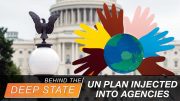
On nearly every calendar Tuesday, April 22, 2014 is denoted as “Earth Day,” putting it into the same category as “Presidents’ Day” or “Independence Day.” Indeed, some consider it the most holy of secular celebrations, the culmination of more than four decades of indoctrination of the theme that it’s moral to force people to go green.
In a burst of excessive enthusiasm, Margaret Mead, a cultural anthropologist icon and agreeable participant in several marriages as well as romantic relationships with other women, once wrote:
Earth Day is the first holy day which transcends all national borders, yet preserves all geographical integrities, spans mountains and oceans and time belts, and yet brings people all over the world into one resonating accord, is devoted to the preservation of the harmony in nature and yet draws upon the triumphs of technology, the measurement of time, and instantaneous communication through space.
Earth Day draws on astronomical phenomena in a new way … by using the vernal Equinox, the time when the Sun crosses the equator making the length of night and day equal in all parts of the Earth.
Unfortunately for Mead, the vernal Equinox actually occurred this year on March 20, showing vividly her confusion not only about astronomy but also about religion, science, and the proper role of government.
The original founder of Earth Day was an unprepossessing soul, John McConnell, who was also a Christian who took his religion seriously. His faith taught him that believers had a responsibility to take care of the Earth as stewards, and he often quoted from Psalm 115:16: “The heaven, even the heavens, are the LORD’S: but the earth hath he given to the children of men.”
In October, 1969 he proposed a global holiday to celebrate the Earth at the national UNESCO Conference in San Francisco, perhaps not realizing that his idea would be coopted by former Wisconsin Senator Gaylord Nelson, who turned the idea into a movement to promote his environmental agenda. Once he realized that his idea had been seized by internationalists, McConnell quickly distanced himself from them, noting in particular that “John McConnell is not associated with … self-proclaimed Earthday founder Senator Gaylord Nelson.”
The first “teach-in” by Nelson took place on April 22, 1970 with the help of green activist Denis Hayes. This year the “holy” secular Earth Day will likely be celebrated in more than 190 countries around the world — making it, according to Hayes, “the largest secular holiday in the world, celebrated by more than a billion people every year.”
Various theories are extant about why April 22 instead of March 20, including trying to set the date during spring break, avoiding true religious holidays such as Easter and Passover, while honoring green believers. One of them, conservationist (not an “environmentalist” by today’s definition) John Muir, was born the day before, 132 years earlier, on April 21, 1838.
Perhaps more conveniently, April 22, 1970 was the 100th anniversary of the birth of Vladimir Lenin, the first totalitarian to inflict his own view of Earth Day onto the hapless citizens of the Soviet Union. Called a “subbotnik,” the first day of enforced cleaning of streets and public parks occurred on April 12, 1919.
So infused is the Earth Day message into the culture that economist Steven Landsburg wrote about it in his book The Armchair Economist, complaining that his four-year-old daughter was being subjected in public school to the indoctrination without proof. Here’s Landsburg:
At the age of four, my daughter earned her second diploma. When she was two, she graduated with the highest possible honors from the Toddler Room at her nursery school in Colorado. Two years later she graduated from the preschool of the Jewish Community Center, where she matriculated on our return to New York State.
At the graduation ceremony, titled Friends of the Earth, I was lectured by four- and five-year-olds on the importance of safe energy sources, mass transportation, and recycling. The recurring mantra was “With privilege comes responsibility” as in “With the privilege of living on this planet comes the responsibility to care for it.”
Of course, Thomas Jefferson thought that life on this planet was more an inalienable right than a privilege, but then he had never been to preschool.
After attempting to open the mind of his daughter’s teacher about the indoctrination she was feeding his daughter, Landsburg realized that he was not dealing with rational thinking, but with a religious ideology that ignored facts that countered the faith. Landsburg explained:
The hallmark of science is a commitment to follow arguments to their logical conclusions; the hallmark of certain kinds of religion is a slick appeal to logic followed by a hasty retreat if it points in an unexpected direction.
Environmentalists can quote reams of statistics on the importance of trees and then jump to the conclusion that recycling paper is a good idea. But the opposite conclusion makes equal sense…
This suggests that environmentalists — at least the ones I have met — have no real interest in maintaining the tree population. If they did, they would seriously inquire into the long-term effects of recycling.
I suspect that they don’t want to do that because their real concern is with the ritual of recycling itself, not with its consequences. The underlying need to sacrifice, and to compel others to sacrifice, is a fundamentally religious impulse. (Emphasis added.)
Earth Day this year on Tuesday, April 22, is the 45th celebration of the marriage of worship of the Earth and the state.
A graduate of Cornell University and a former investment advisor, Bob is a regular contributor to The New American magazine and blogs frequently at www.LightFromTheRight.com, primarily on economics and politics. He can be reached at [email protected].




